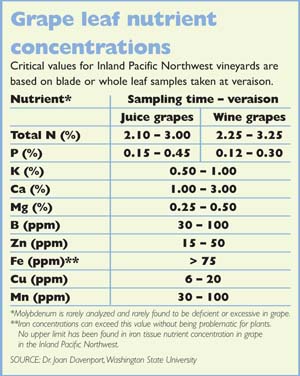Dr. Joan Davenport, who has long championed the need for grape nutrition guidelines specific to the Pacific Northwest, is in the process of publishing an Extension bulletin with the new recommendations.
The long- awaited nutritional standards developed specifically for Pacific Northwest juice and wine grapes are in the process of being published, following several years of work by Washington State University’s Dr. Joan Davenport.
The WSU soil scientist has conducted research projects dating back to 1999 to evaluate nutrient concentrations in both juice and wine grape leaf tissues in her efforts to develop meaningful guidelines for Northwest grape growers. The research has been a combination of surveying nutrient levels in grape tissue samples and field fertilizer plots from a large cross-section of irrigated vineyards of the Inland Pacific Northwest (eastern Washington, eastern Oregon, and Idaho). Davenport is currently writing up an extension bulletin collaboratively with Oregon State University’s Dr. Don Horneck.
Until now, Northwest growers have had to primarily rely on guidelines developed by Dr. Peter Christensen of the University of California, Davis, or from other regions that have different climates than the Northwest. Christensen’s work was based on Thompson Seedless grapes, a variety that is in the vinifera family but is grown in a much different manner than vinifera varieties produced for premium wine in the Inland Northwest.
Another major difference between the Inland Northwest and other grape regions for which published standards have been developed is precipitation. “It doesn’t rain here in the summer as it does in other regions,” Davenport said during a an interview in her office. “And, even though we irrigate, our soils are relatively dry. There’s very little plant-available soil moisture in our wine grapes when we irrigate because the soil moisture is tied up very tightly.”
For her study, vine petiole, leaf, and whole blade samples were collected at bloom and veraison and analyzed for macro- and micronutrient levels. At bloom, the sample location was the leaf opposite the first fruit cluster; at veraison, it was the fifth fully expanded leaf position. A commercial laboratory conducted the tissue analyses.
 Field trials
Field trials
Along with the tissue-testing survey, Davenport conducted a nitrogen fertilizer trial in sandy and silt loam soil types with Merlot and Riesling grapes, comparing four nitrogen rates with application split across four times. Plant tissue was dried, ground, and analyzed at a commercial laboratory for various nutrients, with the petioles and blades analyzed for nitrate and nitrogen. The field trial was conducted to observe plant response to the nitrogen applications.
While she didn’t find statistically significant results in Riesling, she did see a response in the nitrogen levels of petiole and blade samples of Merlot from increased nitrogen applications.
Not petioles, not at bloom
Two factors that the tissue survey and field trial highlighted were the importance of leaf blade or whole leaf samples and the timing of sampling.
In California, growers commonly use petioles for tissue analysis, measuring nitrate nitrogen instead of total nitrogen. But Davenport’s research showed that petiole analysis for irrigated Northwest grapes was inconsistent with other published standards. Additionally, the timing of collecting samples made a difference. Grapevine leaf tissue nutrient concentrations were more stable at veraison, and far less so at bloom.
“Regional differences are likely due to our typically dry soil conditions in the irrigated inland Pacific Northwest,” she said. “And, because Washington growers are keeping their wine grape canopies small through plant water stress, nitrate is not moving around the plant at bloom time.”
In comparing the range of nutrient levels found in the Northwest with other guidelines, she said that, in general, petiole bloom sample values were well below California standards, making the petiole samples at bloom meaningless. “Only eight percent of the nitrogen petiole bloom samples that we took were within the range of the other published guidelines. Eight percent. That’s ridiculous,” Davenport said.
However, nutrient levels from blade samples taken at veraison tracked much closer to the other guidelines.
She says that the real risk of seeing low petiole nitrates at bloom—when a plant really isn’t deficient in nitrogen—is that growers may put on more nitrogen than they’ll ever need. “In sandy soils, excess nitrogen can leach out, and you’re wasting your money. But in a silt loam soil, if you have a wet winter, it can come back to bite you. Very likely, the excess nitrogen will show up the next season and impact your fruit quality.”
For grape growers in the Northwest, tissue samples should be taken during veraison and not at bloom, she advised. “The tricky bit is that if you are trying to use the information to modify your management practices for that season, it is really too late. In reality, your veraison sampling is your guide for the next year.”
The nutrient level recommendations she developed are consistent with the range of nutrient levels to be expected in irrigated, Northwest vineyards with reasonable crop quality and standard production practices.
She has also developed nutrient guidelines for juice grapes, values which are similar to wine grapes except for nitrogen and phosphorus levels.
Her research was funded by the Washington Wine Advisory Committee and the Northwest Center for Small Fruits Research.

Leave A Comment